This is our latest selection of worldwide publications and patents in english on Corrosion Resistance, between many scientific online journals, classified and focused on corrosion resistance, passivation, galvanic corrosion, pitting corrosion, crevice corrosion, stress corrosion cracking, stress corrosion, corrosion cracking, uniform corrosion, corrosion inhibitor, anodic protection, corrosion rate, corrosion fatigue, corrosion mechanism, electrochemical corrosion, corrosion-resistant, cathodic protection, protective revêtement and corrosion resistance classification.
Publication : pas de nouvelles récentes sur ce sujet particulier. Veuillez essayer la recherche manuelle approfondie dans la base de données des publications dont le lien figure juste au-dessus.
Brevets : pas d'actualité brevet sur ce sujet particulier. Veuillez essayer la recherche manuelle approfondie dans la base de données des brevets dont le lien figure juste au-dessus.










